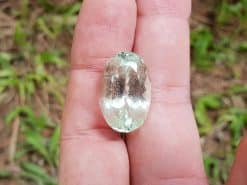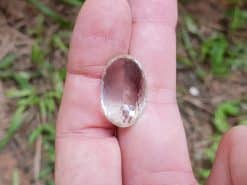Hiddenite

Hiddenite can be considered a gemstone, a stone, a gem or a crystal.
Buy natural hiddenite side in our shop
Hiddenite crystal is a green variety of spodumene that is used as a gemstone.
The first specimens of green variety of spodumene were recovered about 1879. Near the tiny settlement of White Plains, west of Stony Point, Alexander County, North Carolina, USA.
According to contemporary accounts, a young man named Lackey brought it to the attention of J.A.D. Stephenson. A local merchant who was also an ardent collector of minerals.
Why was hiddenite given its name?
Initially, yellowish to greenish-yellow spodumene were thought to be diopside. Stephenson brought the discovery to the attention of exploration geologist William Earl Hidden. He was looking for sources of platinum in North Carolina. An effort that was, in and of itself, unsuccessful.
Then, he sent samples of the odd green material to J. Lawrence Smith. A prominent chemist and mineralogist of Louisville, Kentucky.
Smith correctly identified the specimens as being a variety of spodumene. He named that stone “hiddenite” in honor of William Earl Hidden.
Finally, the name of the stone changed to hiddenite gem, where their were first found.
During the hey-day of mining in the 1880s and 1890s, gemstones miners choose the name “lithia emerald”. Hidden recognized the value of the emeralds and the potential of the new gem green spodumene.
He acquired a tract of poor quality land, which was either the site of the initial discovery or near to it, for $1500. The company Emerald and Mining Company organized the excavations on the site quickly recovered stones in bulk
Where to find hiddenites?
We can found it in USA, Brazil, also in China, and Madagascar.
There is a modest amounts of controversy about some green spodumene. Some found in Afghanistan and also Pakistan. The mineral and gemological communities debate over whether or not the question : Should we call the stone an irradiated green spodumene? The green coloration can change by irradiation and is fugitive also .
Hiddenite meaning and healing properties benefits
The following section is pseudo scientific and based on cultural beliefs.
The stone helps to heal deep emotional traumas and allows you to accept and give love on all levels. This stone opens your heart’s center to divine love and helps you on your path of recovery from abuse or addiction. The gemstone has an exceptional energy of addressing the issues and rebalancing the heart chakra.
Hiddenite from Pakistan
FAQ
What is hiddenite stone used for?
The gemstone can help treat heart conditions and circulatory problems. The gemstone helps to reduce stress and stress or anxiety related illness. The crystal can help stabilize mood swings.
What is hiddenite worth?
The average cost of the gem is between 50$ US to 200$ US per carat, but the value of the stone can vary widely according to the cut, clarity, color, and carat weight of the stone. It also depends on where you buy the gem.
What does hiddenite gemstone look like?
The crystal varies in color from an almost imperceptible and almost clear light-green to yellow-green and at its darkest, deep bottle emerald green. It is yellow-green, green-yellow or emerald-green in color. It is pleochroic, which means that it displays different colors when seen at different angles.
What makes hiddenite green?
Some crystals are reportedly heated to 300º Celsius to turn them green and ensure that they stay green. This treatment is used for making jewelry. It is an attractive gem mineral, but is rare and for the most part known only to collectors.
Natural hiddenite for sale in our gem shop
We make custom made hiddenite jewelry as engagement rings, necklaces, stud earrings, bracelets, pendants… Please contact us for a quote.




